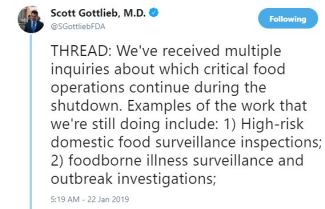New & Views: Shutdown snapshots, Gene Therapy policies, Sentinel safety surveillance, 510(k) modernization, Accelerated Approval labeling
Shutdown Snapshots




 New policies to advance development of safe and effective cell and gene therapies
New policies to advance development of safe and effective cell and gene therapies
Surge of cell and gene therapy products reflecting significant scientific advancement
- Anticipate >200 INDs /year by 2020
- Anticipate approving 10 1 20 cell and gene therapy products/year by 2025
New policies to advance development and approval
- Expediting programs including regenerative medicine advanced therapy (RMAT) designation and accelerated approval
- Series of clinical guidance documents on different areas of development including neurodegenerative diseases
- Efficient pathways for regulatory compliance particularly to assist small sponsors, including academic investigators
 The Future of FDA’s Electronic Safety Surveillance
The Future of FDA’s Electronic Safety Surveillance
https://www.sentinelinitiative.org/
Sentinel is integral part of FDA’s safety monitoring efforts
- Influential in range of outcomes including label changes, Advisory Committees meetings, safety evidence
- Widespread use of real world evidence (RWE) to increase product development efficiency and lower cost
- Pursuing ways to better incorporate information from electronic health records (EHRs) into pre- and post-market surveillance
Five-year strategy
- Enhance and expand the Sentinel System’s foundation, including data, infrastructure, operations and technology;
- Augment Sentinel’s safety analysis capabilities using advances in data science and signal detection;
- Use Sentinel System to accelerate access to and broaden the use of real world data for real world evidence;
- Broaden the Sentinel System’s ecosystem of stakeholders to pursue the vision of a national resource; and
- Disseminate knowledge and advance regulatory science to encourage innovation and meet the agency’s scientific needs.
 Steps to strengthen its 510(k) pathway by promoting the use of robust performance criteria and modern predicate devices
Steps to strengthen its 510(k) pathway by promoting the use of robust performance criteria and modern predicate devices
Safety and Performance Based Pathway
- Expands approach previously applied through Abbreviated 510(k) Program, based on conformity to FDA-recognized consensus standards
- Show new device meets FDA-identified performance criteria reflecting current technological principles and the safety and performance of modern predicate devices
- May request and review underlying data and testing methodologies for substantially equivalent assessment
Promoting use of more modern predicate devices
- Make public a list of devices or manufacturers who make technologies that rely on predicates that have been on the market for more than a certain number of years (e.g., 10 years)
- Consider using other criteria to inform our point of reference?
- Promote use of more modern predicates
- New authority, such as making at least some older devices ineligible as predicates

Labeling for drugs approved under accelerated approval, reflecting the more frequent use of this pathway for drugs used in certain clinical settings
Focus on indications for drugs approved via accelerated approval based on surrogate endpoint or clinical endpoint other than survival or irreversible morbidity
Example: This indication is approved under accelerated approval based on {state effect on surrogate endpoint or intermediate clinical endpoint that supported the accelerated approval} [see Clinical Studies (14.X)]. Continued approval for this indication may be contingent upon verification and description of clinical benefit in a confirmatory trial(s).
Considerations:
- Limitations of Usefulness and Clinical Benefit : Uncertainty, Continued Approval
- When Clinical Benefit Has Been Verified
- Withdrawal of an Accelerated Approved Indication: Lack of Evidence Concerning the Withdrawn Indication, Safety Information Concerning the Withdrawn Indication
Image credit: FDA